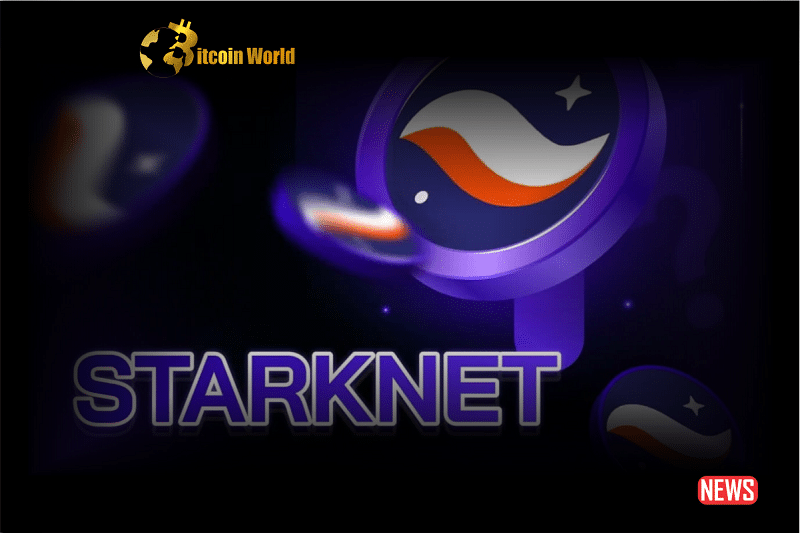The quest for a scalable Ethereum continues, and StarkWare just dropped a major upgrade for its StarkNet Layer 2 network! Think of it like adding extra lanes to a busy highway – making things significantly faster and smoother. Dubbed “Quantum Leap,” this upgrade promises to supercharge the network’s performance, and the initial results are definitely turning heads.
What’s the Big Deal with Quantum Leap?
StarkWare successfully deployed the Quantum Leap upgrade on July 12th, and the numbers speak for themselves. During its public test phase, StarkNet consistently hit 37 transactions per second (TPS), even peaking at an impressive 90 TPS. But it’s not just about speed; it’s also about how quickly those transactions get processed. Quantum Leap managed to bring transaction inclusion latency down to under 10 seconds, beating their own target and matching the pace of the Ethereum mainnet itself. That’s a significant leap forward!
Uri Kolodny, StarkWare’s co-founder and CEO, believes this boost in performance will unlock exciting new possibilities. Imagine:
- Faster DeFi applications: Think quicker trades, more efficient lending and borrowing, and an overall smoother experience.
- Realistic AAA Games on Web3: The kind of games you’re used to playing, but built on blockchain technology, requiring high throughput and low latency.
- More Consumer-Friendly Web3 Services: Making blockchain technology accessible and usable for everyday applications.
The community clearly believes in Quantum Leap, with a whopping 97.9% of voters supporting its mainnet deployment after an eight-day test period. This marks a pivotal moment for StarkNet.
StarkNet and the Zero-Knowledge Revolution
StarkNet has been a pioneer in the Layer 2 space, launching its mainnet in late 2021 with a focus on zero-knowledge (ZK) proofs. This technology has become a hot topic among Ethereum scaling solutions. Projects like zkSync, Polygon, and ConsenSys have all introduced “zkEVM” rollups recently. These rollups use ZK-proofs to secure transactions and are designed to be compatible with the code used on the Ethereum Virtual Machine (EVM), Ethereum’s smart contract engine.
The Cairo Conundrum: StarkNet’s Unique Path
Here’s where StarkNet takes a slightly different route. Unlike many of its competitors, StarkNet isn’t EVM-compatible. This means developers who have built applications and protocols on Ethereum need to recompile their code in Cairo, StarkNet’s native programming language, to deploy on the network.
Is This a Hurdle or an Advantage?
While recompiling code might seem like an extra step, StarkWare is betting that the superior throughput offered by StarkNet will be a major draw for developers. They believe the performance gains outweigh the initial effort of adapting to Cairo.
Looking Ahead: Even More Speed on the Horizon
StarkWare isn’t stopping here. They’re planning to launch a validium in the near future. Think of validiums as close cousins to rollups. Like rollups, they aim to improve scalability, but they primarily store transaction data off-chain. StarkWare anticipates that this will unlock even greater scalability, potentially by “an order of magnitude.” That’s a significant jump!
StarkNet vs. the Competition: How Does It Stack Up?
Let’s take a look at how StarkNet’s current performance compares to the Ethereum mainnet and other leading Layer 2 solutions:
| Network | Transactions Per Second (TPS) |
|---|---|
| Ethereum Mainnet (Daily Average) | ~12 |
| Ethereum Mainnet (Peak) | 22.4 (December) |
| zkSync Era | 11.33 |
| Arbitrum One | 8.6 |
| StarkNet (with Quantum Leap – Testnet) | 37 (Consistent), 90 (Peak) |
Data source: L2beat
As you can see, even in its testnet phase, Quantum Leap significantly boosts StarkNet’s potential throughput, positioning it as a strong contender in the Layer 2 race.
The Bottom Line: A Quantum Leap for Ethereum’s Future?
StarkNet’s Quantum Leap upgrade is more than just a performance boost; it’s a statement of intent. By focusing on ZK-proof technology and pushing the boundaries of throughput, StarkWare is contributing significantly to the ongoing effort to make Ethereum more scalable and accessible. While the requirement to code in Cairo presents a unique challenge, the potential benefits in terms of speed and efficiency are hard to ignore. As the Ethereum ecosystem continues to evolve, innovations like Quantum Leap are crucial for paving the way for wider adoption and unlocking the full potential of decentralized applications.
Disclaimer: The information provided is not trading advice, Bitcoinworld.co.in holds no liability for any investments made based on the information provided on this page. We strongly recommend independent research and/or consultation with a qualified professional before making any investment decisions.


